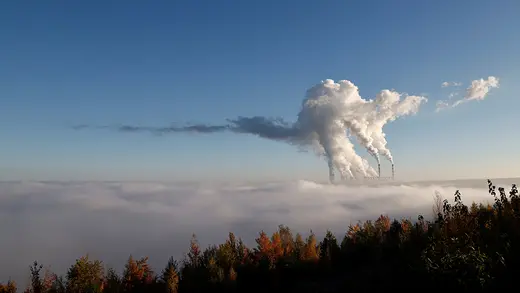[ad_1]
Europe is scrambling to search out alternate options to Russian vitality amid the struggle in Ukraine. With customers going through the best vitality costs on report and potential fuel rationing or blackouts this winter, there are fears of a good worse disaster subsequent 12 months.
Extra From Our Consultants
European Union (EU) nations are pursuing a spread of replacements, however a few of these have environmental drawbacks, whereas others might take years to be put into use. Listed below are 4 methods EU nations are decreasing dependence on Russia.
Returning to Coal Quickly
Extra on:
European Union
Vitality and Setting
Russia
Geopolitics of Vitality
Renewable Vitality
In an effort to restrict pure fuel utilization, some European nations are burning extra coal this winter, slowing earlier agreements to section it out. Coal is the dirtiest vitality supply, accounting for round 40 % of worldwide greenhouse fuel emissions from fossil gas use. Nevertheless, it stays broadly accessible and can be utilized instantly in present energy crops.
Germany, which has vowed to cease utilizing coal by 2030, is shifting some energy crops again to coal. Financial system minister Robert Habeck referred to as the transfer “bitter however indispensable” for Berlin’s purpose of ending all Russian fuel imports by mid-2024. Likewise, France has reopened a not too long ago closed coal plant, the Netherlands eliminated a manufacturing cap on coal energy, and plenty of different EU nations are equally embracing coal.
Accessing New Sources of Gasoline
Practically 40 % of Europe’s pure fuel, some 155 billion cubic meters (bcm), got here from Russia final 12 months. With European properties and companies set to be depending on fuel for at the very least the following decade, the search is on for different sources.
Extra From Our Consultants
North Sea vitality has already crammed a few of the hole. Norway overtook Russia as Europe’s largest piped fuel provider after growing output to 122 bcm this 12 months, an 8 % enhance in comparison with 2021, and it opened a brand new pipeline to Poland in October. Denmark, the Netherlands, and the UK (UK) are additionally boosting manufacturing and green-lighting new fuel initiatives, although many of those will take years to return on-line. Analysts say there’s a ceiling to this technique, as provides within the North Sea are operating out.
One other avenue is liquefied pure fuel (LNG). The US has mentioned it’ll enhance its LNG exports to the EU from fifteen bcm this 12 months to fifty bcm yearly by 2030, or about one-third of the fuel provide beforehand supplied by Russia. The elevated demand has additionally set off a “sprint for fuel” from African nations with important reserves, reminiscent of Egypt and Nigeria. Jap Mediterranean fuel manufacturing is being expanded as properly. However there are difficulties: extra LNG, which is shipped by sea, would require new coastal import terminals and distribution pipelines. The development of such amenities usually takes two to a few years.
Extra on:
European Union
Vitality and Setting
Russia
Geopolitics of Vitality
Renewable Vitality
In the meantime, the EU has fast-tracked some pipeline initiatives, together with a cope with Azerbaijan that goals to ultimately double the nation’s present eight bcm per 12 months of fuel exports. However different accelerated pipeline plans have confronted authorized challenges from conservation teams. Environmental advocates fear that investing in new pure fuel infrastructure will disincentivize the change to renewables.
Renewing Nuclear
There stays no consensus on nuclear vitality amongst EU nations; about half presently produce any. France leads the bloc, utilizing nuclear for practically 70 % of its electrical energy wants. On the different excessive is Germany, which had deliberate to close down its final crops this 12 months. Within the Nineties, it was getting one-third of its energy from nuclear sources.
Russia’s struggle has shifted the talk. Germany has now delay closing its remaining three nuclear crops till at the very least 2023. A number of different European nations, together with Finland, Spain, and Sweden, have elevated their nuclear crops’ capacities.
However critically boosting nuclear vitality can be difficult. Greater than half of France’s reactors are presently shut down as a consequence of upkeep points, limiting its export talents. Germany’s reactors account for simply 6 % of its electrical energy, however constructing extra would take practically a decade, and Russian firms presently present a lot of the uranium essential to function them.
Growing Renewables
The EU has rolled out an bold renewable vitality plan that it hopes will obtain two targets: decreasing emissions and eliminating the necessity for Russian fossil fuels. The plan, often called RePowerEU, seeks to have 45 % of the bloc’s vitality come from renewable sources by 2030, up from 22 % in 2020. The EU foresees investing greater than $210 billion within the plan by 2027. It will construct upon earlier plans to attain net-zero emissions by 2050, which means the quantity of greenhouse fuel emitted can be equal to the quantity faraway from the environment.
As well as, the EU has pledged to spend money on infrastructure for hydrogen and biomethane, that are cleaner alternate options to fuel, whereas doubling wind and photo voltaic capability. EU members additionally purpose to lower total vitality consumption by 15 % by means of voluntary measures reminiscent of turning down the warmth in public buildings and inspiring the general public to restrict use of family home equipment.
Proponents of the plan say that these measures taken collectively can exchange some two-thirds of the vitality beforehand provided by Russia. Nonetheless, the Worldwide Vitality Company forecasts that though the EU will dramatically develop use of renewables by 2030, it’ll fall in need of the RePowerEU purpose as a consequence of challenges in boosting renewable capability.
Jacqueline Jedrych is an editorial intern at CFR.
[ad_2]
Source_link













